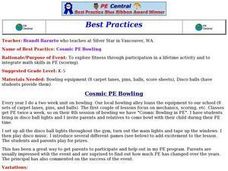Curated OER
Cosmic PE Bowling
Students explore fitness through participation in a lifetime activity. They are shown the mechanics, scoring, etc for bowling. Students recieve PE twice a week during this time. They have what is called "Cosmic Bowling in PE" during...
Curated OER
Solar Lesson
First graders complete sunlight and solar effects activities to learn about light and its power. For this solar activity lesson, 1st graders complete a sunscreen test activity, a light test, a black light test, a cloudy test, a...
Curated OER
Reflections
Students are given materials with various textures and light sources to investigate specular reflection, diffuse, reflection, angle of incidence, and angle of reflection. Students draw and label an everyday scenario showing specular and...
Curated OER
Getting the Meaning in Pop Music
Critical thinkers compare the impact of visual versus aural perception in how they comprehend artistic intent. They consider the meaning of a set of pop lyrics first by reading them, then by listening to them orally, and finally viewing...
Georgia Career, Technical, and Agricultural Education
World of Fashion — Vocabulary Worksheet
Make sure your fashionistas know how to talk about all the latest and oldest styles. Partners work together to define 18 fashion-related terms, ranging from style to home furnishings. Definitions are included on the second page of the...
Curated OER
Was, Were, There Was, There Were
In this usage of was/were and there was/there were online worksheet, learners complete 45 sentences with the proper word or words. They use the drop-down menus to choose the words that fit properly in each sentence. They page contains...
Curated OER
Homophones Exercise
In this vocabulary skills worksheet, students examine homophones as they respond to 26 questions that require them to match homophones and select the appropriate homophones to complete sentences.








